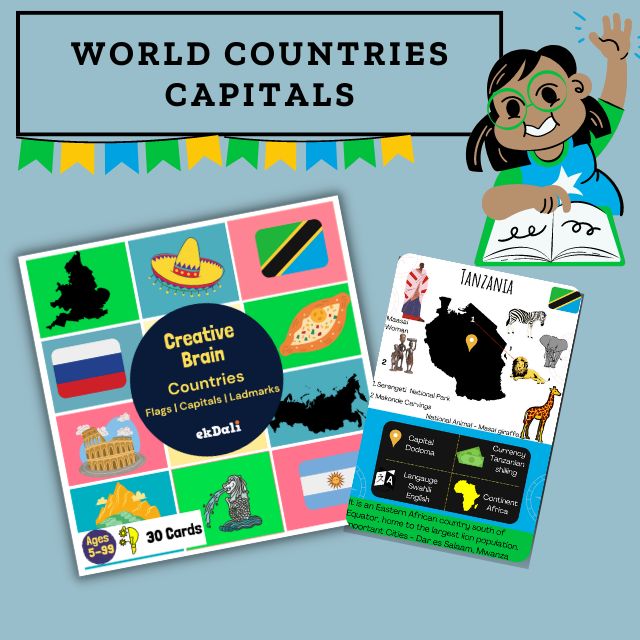Before you jump into the blog, we thought you might like to check out our Creatibe Brain World Country Flashcards
MEXICO FACTS FOR KIDS
Mexico is a country in North America and the third-largest country in Latin America. It is the most populous Spanish-speaking country in the world.
MEXICO QUICK FACTS
|
Official name: United Mexican States |
|
Capital: Mexico City |
|
Official Language: Spanish |
|
Currency: Mexican Peso |
|
Continent: North America |
|
Population: 126.3 million |
|
Major rivers: Rio Grande, Colorado, Grijalva |
|
Major Cities: Tijuana, Ecatepec, Leon |
|
Major Mountains: Pico de Orizabo, Iztaccihuatl, Sierra Negra |
|
National Sport: Charreria |
|
National Bird: Crested Caracara |
|
National Tree: Montezuma Cypress |
|
National Animal: Golden Eagle |
|
National Flower: Dahlia |
|
National Fruit: Avacado |
MEXICO GEOGRAPHY AND CLIMATE
Mexico’s geographical features range from swamp to desert and from tropical lowland jungle to high alpine vegetation. Half of the country is at an altitude greater than 1000 meters. The central landmass plateau is flanked by mountains. The north side of this plateau is arid and less populated.
Mexico's climate varies from arid to tropical, with a defined split. The Tropic of Cancer divides the country into two so one part is temperate and the other, tropical. Therefore, land to the north has cooler temperatures during the winter months while more southerly regions see temperatures remain constant year-round.
MEXICO PEOPLE, CULTURE, AND FOOD
About 68 Different Indigenous Peoples inhabit Mexican territory, each of which speaks a native language of their own. The mestizo group accounts for 62% of the population. Indigenous Central American or predominantly indigenous Central American people account for 21%, while 10% of the population has a mostly European background.
El Mariachi (Carlos Gallardo) is a traveling guitar player with a modest desire to play music for a living. Sombrero, a broad-brimmed high-crowned hat made of felt or straw, worn especially in Mexico. The sombrero, its name derived from the Spanish word Sombra, meaning “shade,” first appeared in the 15th century.
Mexican culture is a hugely diverse domain that encompasses vast differences in identity. The variety of influences throughout Mexican history, from the ancient Mayan and Aztec civilizations to the domineering European presence, has come to shape and define the enthralling country it is today.
One of the most traditional foods from Mexico is pozole, a maiz soup. Traditional Mexican pozole (pronounced PO-zo-lay), is made with hominy and meat and cooked in broth. Then, plenty of spices are added in, such as garlic, cumin, and chili powder.
MEXICO FLAG
The national flag of Mexico is a vertical tricolor of green, white, and red with the national coat of arms charged in the center of the white stripe. Green symbolizes independence, white is for the Roman Catholic religion, and red is for the union. The coat of arms of Mexico depicts a Mexican (golden) eagle perched on a prickly pear cactus devouring a rattlesnake. The image of the eagle devouring the serpent stands for the fact that Mexicans are always ready to achieve victory over whoever intends to harm them. Lastly, the thorny cactus indicates endless challenges and the rock and water indicate Mexico’s land and sea.
MEXICO FLORA AND FAUNA
The country is home to 25,000–30,000 species of plants. Mexico boasts the highest number of pine and oak species in the world. Other notable trees include mahogany, zapote, and ceiba. Mexican Sunflower, Laelia Orchid, Pineapple Sage, Mexican Honeysuckle, Poinsettia, and Mexican Marigold are native flower varieties.
Mexico ranks first in biodiversity in reptiles with 707 known species, second in mammals with 438 species, fourth in amphibians with 290 species, and fourth in flora, with 26,000 different species. Some exotic animals found in the region are Spider monkeys, Axolotl, Cacomistle, Mexican prairie dogs, Ocelots, Vaquita porpoises, Coati, and Cenzontle. Birds native to Mexico are Cockatoos, Bat Falcon, Royal flycatchers, Piaya cayana, and Squirrel Cuckoo. Budgie, Cinnamon Hummingbird.
The world’s second-largest barrier reef is located off the coast of Mexico along the Caribbean coastline of the Yucatan Peninsula. The reef ecosystem is home to over 66 species of stony corals and more than 500 species of fish.
MEXICO POPULAR SPORT
The most popular sport in Mexico currently is football followed by boxing. There are regional variations: for example, baseball is the most popular sport in the northwest and the southeast of the country. Basketball, American football, and bull riding are also popular.
MEXICO TOURIST ATTRACTION
Chichen Itza: The Maya civilization was a Mesoamerican civilization developed by the Maya people. Chichen Itza is a complex of Mayan ruins centrally located on the northern half of Mexico's Yucatan Peninsula. The main pyramid nests multiple smaller pyramids inside it.
Church of Santa Prisca de Taxco: The Parroquia de Santa Prisca y San Sebastían, commonly known as the Church of Santa Prisca, is a colonial monument located in the city of Taxco de Alarcón, in the southern state of Guerrero, Mexico, built between 1751 and 1758. It is located on the east side of the main plaza of Taxco. Church of Santa Prisca de Taxco.
Alban Ruins: Monte Alban, the most significant archeological site in the Oaxaca Valley, is one of the most important archaeological zones in Mesoamerica. The ruins of Monte Albán – which include pyramids, canals, and a ballgame court – sit on a semi-arid hilltop above the city of Oaxaca. religious capital for the Zapotec people.
Metropolitan Cathedral Mexico City: The Metropolitan Cathedral of the Assumption of the Most Blessed Virgin Mary into Heaven is the cathedral church of the Roman Catholic Archdiocese of Mexico; it contains a summary of five centuries worth of Mexican art and architecture.
At Ekdali we believe children doa. lot of free play and enjoy Screen Free conversations. Our Maps, posters, colouring maps and flashcards are designed exactly for this . Please do check
























